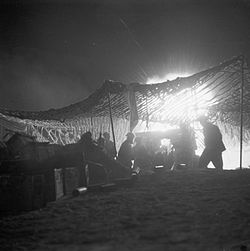| Battle of the Mareth Line | |||||||
|---|---|---|---|---|---|---|---|
| Part of the Tunisia Campaign of the Second World War | |||||||
 A British 25-pounder field gun in action at night, during the assault on the Mareth Line | |||||||
| |||||||
| Belligerents | |||||||
|
| |||||||
| Commanders and leaders | |||||||
|
|
| ||||||
| Units involved | |||||||
|
|
| ||||||
| Strength | |||||||
| 90,000 of 123,690 men[1] |
73,500 of 115,000 men 455 guns 139–220 tanks 480 anti-tank guns seventy-five 88 mm guns[1] | ||||||
| Casualties and losses | |||||||
| 4,000 | 7,000 (POW) | ||||||
The Battle of the Mareth Line or the Battle of Mareth was an attack in the Second World War by the British Eighth Army (led by General Bernard Montgomery) in Tunisia, against the Mareth Line held by the Italo-German 1st Army (led by General Giovanni Messe). It was the first big operation by the Eighth Army since the Second Battle of El Alamein 4+1⁄2 months previously. On 19 March 1943, Operation Pugilist, the first British attack, established a bridgehead but a break-out attempt was defeated by Axis counter-attacks. Pugilist established an alternative route of attack and Operation Supercharge II, an outflanking manoeuvre via the Tebaga Gap was planned. Montgomery reinforced the flanking attack, which from 26 to 31 March, forced the 1st Army to retreat to Wadi Akarit, another 40 mi (64 km) back in Tunisia.
- ^ a b Stevens 1962, p. 173.